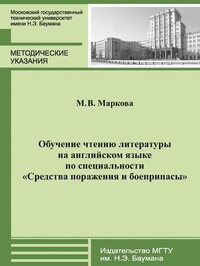Обучение чтению литературы на английском языке по специальности «Средства поражения и боеприпасы»
Покупка
Тематика:
Английский язык
Автор:
Маркова Мария Владимировна
Год издания: 2013
Кол-во страниц: 48
Дополнительно
Вид издания:
Учебно-методическая литература
Уровень образования:
ВО - Бакалавриат
ISBN: 978-5-7038-3757-3
Артикул: 840467.01.99
В методических указаниях приведены оригинальные тексты на английском языке по специальности «Средства поражения и боеприпасы», упражнения на развитие навыков чтения и понимания научно-технических текстов, повторение грамматического материала, освоение технической лексики, а также упражнения на развитие навыков устной речи и умения вести беседу по специальности на английском языке. Для студентов третьего курса факультета «Специальное машиностроение» МГТУ им. Н.Э. Баумана. Рекомендовано Учебно-методической комиссией Научно-учебного комплекса «Фундаментальные науки» МГТУ им. Н.Э. Баумана.
Скопировать запись
Фрагмент текстового слоя документа размещен для индексирующих роботов
Московский государственный технический университет имени Н.Э. Баумана М. В. Маркова Обучение чтению литературы на английском языке по специальности «Средства поражения и боеприпасы» Методические указания М о с к в а Издательство МГТУ им. Н.Э. Баумана 2 0 1 3
УДК 802.0
ББК 81.2Англ-923
М26
Рецензент З. А. Заболотская
Маркова М. В.
М 6 Обучение чтению литературы на английском языке по
специальности «Средства поражения и боеприпасы» : метод.
указания / М. В. Маркова. — М.: Изд-во МГТУ им. Н.Э. Баумана, 2013. — 44, [4] с. : ил.
ISBN 978-5-7038-3757-3
В методических указаниях приведены оригинальные тексты на
английском языке по специальности «Средства поражения и боеприпасы», упражнения на развитие навыков чтения и понимания
научно-технических текстов, повторение грамматического материала, освоение технической лексики, а также упражнения на развитие навыков устной речи и умения вести беседу по специальности
на английском языке
Для студентов третьего курса факультета «Специальное
машиностроение» МГТУ им. Н.Э. Баумана.
Рекомендовано Учебно-методической комиссией Научно-учебного комплекса «Фундаментальные науки» МГТУ им. Н.Э. Баумана.
УДК 802.0
ББК 81.2Англ-923
ISBN 978-5-7038-3757-3
© МГТУ им. Н.Э. Баумана, 2013
М26
ПРЕДИСЛОВИЕ В методических указаниях содержатся оригинальные тексты из специализированных анголоязычных изданий, подготовленные для аудиторной и самостоятельной работы студентов, обучающихся по специальности «Средства поражения и боеприпасы» (V–VII семестры). Пособие состоит из трех разделов, в каждом представлены тексты и упражнения, целью которых является отработка навыков различных видов чтения (просмотрового, поискового, изучающего), упражнения на закрепление вводимого лексического материала, требующегося для понимания и перевода технических текстов, а также творческие упражнения, предназначенные для развития навыков устной речи на английском языке по специальности «Средства поражения и боеприпасы».
UNIT 1 INTRODUCTION TO EXPLOSIVE MATERIALS Text 1.1 The Basics Before you read the text, imagine you need to tell your younger brother or sister, who is still at secondary school, what an explosion is. Try to write a short explanation, keeping it as simple as possible. Then read the text and compare it with your written sample. The fundamental concept behind explosives is very simple. At the most basic level, an explosive is just something that burns or decomposes very quickly, producing a lot of heat and gas in a short amount of time. A typical explosive charge consists of some explosive material, some sort of detonation device and, typically, some sort of housing. The explosive material undergoes a rapid chemical reaction, either a combustion or decomposition reaction, when triggered by heat or shock energy from the detonator. In the chemical reaction, compounds break down to form various gases. The reactants (the original chemical compounds) have a lot of energy stored up as chemical bonds between different atoms. When the compound molecules break apart, the products (the resulting gases) may use some of this energy to form new bonds, but not all of it. Most of the “leftover” energy takes the form of extreme heat. The concentrated gases are under very high pressure, so they expand rapidly. The heat speeds up the individual gas particles, boosting the pressure even higher. If the gas expands faster than the speed of sound, it generates a powerful shock wave. The pressure can
also push pieces of solid material outward at great speed, causing them to hit people or structures with a lot of force. The explosion actually has two phases. The initial expansion inflicts most of the damage. It also creates a very low-pressure area around the explosion’s origin — the gases are moving outward so rapidly that they suck most of the gas out from the “middle” of the explosion. After the outward blast, gases rush back in to the partial vacuum, creating a second, less-destructive inward energy wave. In low explosives, such as the propellant in a bullet cartridge, the reaction occurs relatively slowly and the pressure isn’t as damaging. The expanding gases only serve to push a small object. High explosives, such as C-4 and TNT, expand more rapidly, generating much greater pressure. In a high explosive, the gas pressure is strong enough to destroy structures and injure and kill people. Explosives experts refer to rapid explosive reactions as detonation and slower explosive reactions as deflagration. Active vocabulary blast n. [blɑ:st] bond n. [bɔnd] combustion n. [kəm ʹbʌstʃən] compound n. [ʹkɔmpaʊnd] decomposition n. [ˏdi:kɔmpəʹzɪʃən] deflagration n. [ˏdɛfləʹgreɪʃən] detonation n. [ˏdɛtəʹneɪʃən] expand v. [ɪk ʹspænd] expansion n. [ɪkʹspænʃən] explosion n. [ɪkʹspləʊʒən] explosive adj., n. [ɪkʹspləʊsɪv] high explosive n. [ʹhaɪ ɪkʹspləʊsɪv] housing n. [ʹhaʊzɪη] low explosive n. [ʹləʊ ɪkʹspləʊsɪv] pressure n. [ ʹprɛʃə] product n. [ʹprɔdʌkt] propellant n. [prəʊʹpɛlənt] reactant n. [rɪʹæktənt] shock n. [ʃɔk] speed of sound n. [ʹspi:d əv ʹsaʊnd] Text 1.2 How Bomb Blasts Cause Damage Look at the picture. Prepare a small written report, describing these events in as much detail as possible, using information from the picture and your personal knowledge. Then read the text and add any


